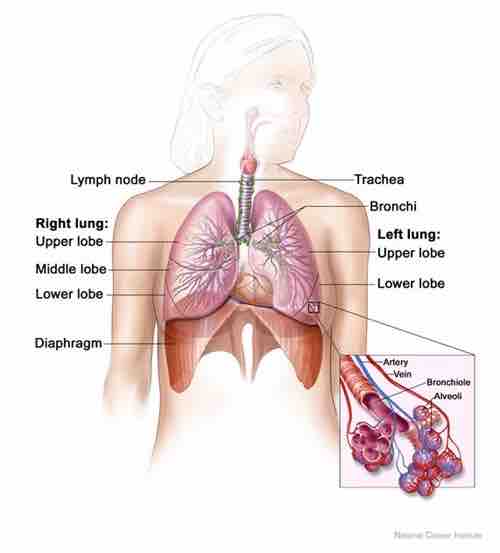The lungs are located in two chambers of the thoracic cavity on either side of the heart. Though similar in appearance, the two lungs are not identical, nor wholly symmetrical.
Fissures are double folds of pleura that divide the lung into lobes. There are three lobes in the right lung and two in the left lung. The lobes are further divided into segments and then into lobules, which are hexagonal divisions of the lungs that are the smallest visible subdivision.

The lobes of the lungs
The right lung has three lobes and the left lung has two.
The lobes are further divided into segments and then into lobules, hexagonal divisions of the lungs that are the smallest subdivision visible to the naked eye.
The Right Lung
The right lung is five centimeters shorter than the left lung to accommodate the diaphragm, which rises higher on the right side over the liver; it is also broader. The volume, the total capacity, and the weight of the right lung is greater than that of the left. The right lung is divided into three lobes.
The Upper Lobe (Right Lung)
The upper lobe is the largest lobe of the right lung. It extends from the apex of the lung down to the horizontal and oblique fissures. It bears apical, anterior, and posterior bronchopulmonary segments.
The Middle Lobe (Right Lung)
The middle lobe is the smallest lobe of the right lung, located between the horizontal and oblique fissures. It bears medial and lateral bronchopulmonary segments.
The Lower Lobe (Right Lung)
The lower lobe is the bottom lobe of the right lung. It lies beneath the oblique fissure. It bears medial, lateral, superior, anterior, and posterior bronchopulmonary segments.
The Left Lung
The human left lung is smaller and narrower that the right lung, and is divided into two lobes, an upper and a lower, by the oblique fissure. The left lung has only two formal lobes because of the space taken up in the left side of the chest cavity by the heart, though it does have the lingula, which is similar to a lobe.
The left lung has a depression on the medial side of its surface called the cardiac notch, a concave impression molded to accommodate the shape of the heart.

The Left Lung
This has a concave depression that accommodates the shape of the heart, called the cardiac notch.
The Upper Lobe (Left Lung)
The upper lobe of the left lung contains anterior and apicoposterior bronchopulmonary segments. It is above the oblique fissure.
The Lower Lobe (Left Lung)
The lower lobe of the left lung contains superior, anterior, posterior, medial, and lateral bronchopulmonary segments.
The Lingula
The lingula is not formally considered to be a lobe. It is a small, tongue-like projection of the left lung that is analogous to the middle lobe of the right lung. It contains superior and inferior bronchopulmonary segments.
The Hilium
Above and behind the cardiac impression is a triangular depression named the hilum. The hilum is the root of the lung where that contains structures that supply the lungs with blood, lymph fluid, and innervation, such as the pulmonary vein, pulmonary artery, pulmonary nerves, and lymphatic vessels.
These structures are enclosed by pleura. There is a hilium for each of the lungs found in the mediastinum (backside) of the lungs. The hilium is thinner in the left lung compared to the right lung because it lies between the cardiac notch and the groove for the aorta.
The hilium is important because it is the primary way in which the respiratory system links with the cardiovascular and nervous systems.